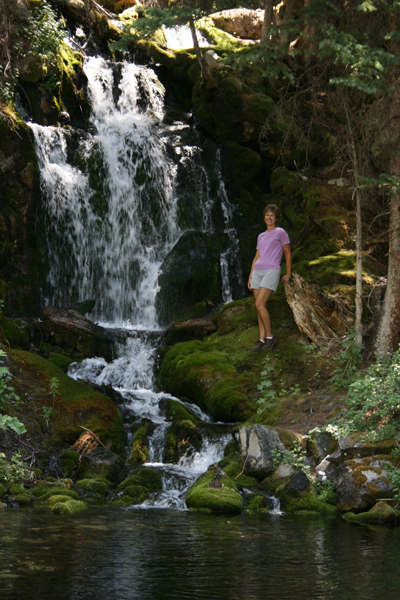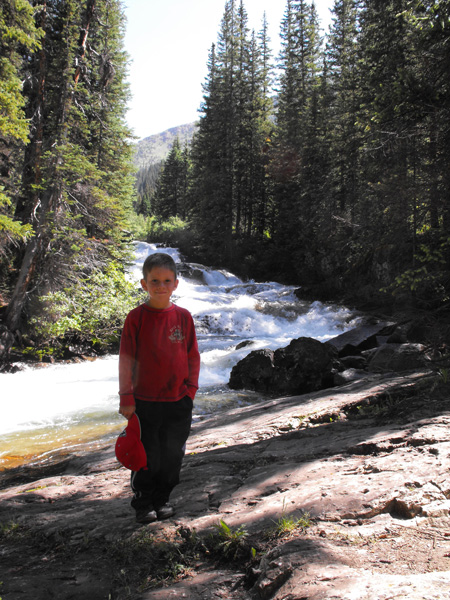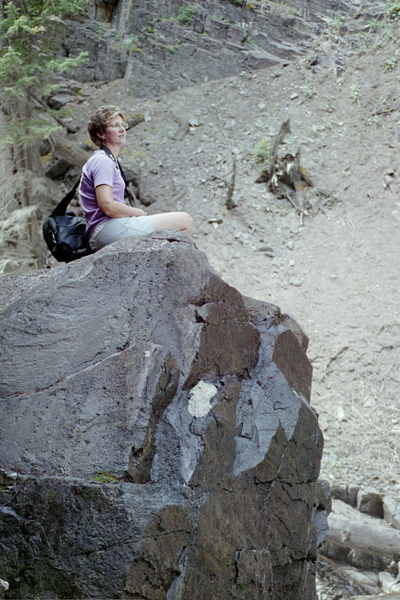For visitors seeking day hikes, back-country overnight trips, and even car camping in barely traveled, splendid alpine scenery, the wilderness areas surrounding Marble are where you want to be.
Some of the most avid resident trekkers and campers have realized that they could spend the rest of their years exploring the charted and uncharted pathways of the wilderness surrounding Marble and probably never experience them all. There are so many miles of trails here that you might hike all day and never encounter other people. US Forest Service Maps and the Marble Tourism Association’s trails link describe some of the most popular circle routes and connections to passes into the watersheds of Aspen/Snowmass and Crested Butte. But for the little-kwnown or secret routes and destinations, local guides and innkeepers might be urged to share ways to places known to only a few and traveled by even fewer.
Some of the summer and fall favorites are Carbonate Creek Trail, Yule Pass Trail, Lost Creek Trail and Raspberry Ridge Trail, but in winter and early spring, the summer jeep roads to Crystal and Lead King Basin become ideal for snowshoeing, backcountry skiing and cautious and respectful snowmobiling.
Many hikes are accessible from your car parked at a trailhead, but many prefer to bivouac at a comfortable local lodging establishment, experiencing splendid hiking by day and returning to all the comforts of lodging at night while picking the brains of lodge owners to plan the next day’s adventure.
Notes for All Wilderness Visitors
Wilderness areas are in a delicate state of natural balance. They are not renewable resources. Any careless act by man can upset this natural balance and result in the destruction of the beauty found in wilderness.
Wilderness Use ethics and regulations
By following the ethics and regulations below you can help protect and preserve the natural features of the wilderness for yours and others’ future visits.
- Out of consideration for others and wildlife – DOGS MUST BE ON A LEASH.
- Human trash – IF YOU PACK IT IN, PACK IT OUT
- Limit group sizes to 10 people and 15 stock or pack animals
- Sanitation – Bury human waste off trails, 100 ft. from water and 6 inches under soil.
- Lightweight camp stoves are recommended and are required above timberline
- Camp 100 feet from water and trails, and use existing sites where possible
- Do not wash or bathe in lakes and streams. Use biodegradable soap far from water source
- Stay on trails and do not shortcut switchbacks, which causes erosion
Alpine Hazards to your Health and Safety
Marble’s wilderness areas range from 8,000 ft. to 14,000 ft. above sea level. When visiting the backcountry, there are two deceptively lethal, dangerous aspects of visiting, particularly if you recently arrived from warmer and lower elevations: Sudden lower temperatures and less oxygen to breathe.
COLD KILLS in two distinct steps: The first step is exposure combined with exhaustion. The moment you begin to lose heat faster than your body produces it, you are undergoing exposure. Two things happen: You voluntarily exercise to stay warm and your body makes involuntary adjustments in its extremities to preserve critical normal temperature in the vital organs.
The second step is hypothermia. If exposure continues until your energy reserves are exhausted, cold reaches the brain, depriving you of some degree of judgment and reasoning power. You will not likely be aware that this is happening. You will lose control of your hands. This is hypothermia.
Without treatment or a source of warmth, this slide in body temperature leads to stupor, collapse, and death. To prevent hypothermia, stay fed, stay dry, stay protected from wind, and understand cold. Most hypothermia cases develop in air temperatures between 30 and 50 degrees. Most outdoorsmen simply can’t believe that such temperatures can be dangerous. If your party is exposed to wind or wet, watch yourself and others for these symptoms:
- Uncontrollable fits of shivering.
- Vague, slow slurred speech.
- Memory lapses, incoherence
- Immobile or fumbling hands
Use rain gear BEFORE you get wet. Carry trail food, nuts, jerky and dried fruit and enough liquids to avoid dehydration by simply drinking as often as you feel thirsty. Dress loosely in layers with at least one layer of wool available, even if the day starts out warm and dry. Wool loses much less insulating value when wet than cotton, nylon or down.
End Exposure – If you cannot stay dry or warm under existing weather conditions, using the clothes and shelter you have with you, be smart enough to give up reaching the peak, getting the fish, impressing the buddy or whatever you had in mind. Return to base!
ALTITUDE SICKNESS is caused by low levels of oxygen in the blood associated with inadequate acclimatization to altitudes higher than 8,000 feet. It is more common in the thinner warm air of summer with persons who have come directly from altitudes of well below 5,000 feet. Persons who live near sea level are particularly at risk. Acute Mountain Sickness (AMS) is a symptom complex characterized by headache, insomnia, loss of appetite, fatigue, nausea, dizziness, breathlessness, reduced urine output and peripheral edema, appearing within a few hours to a few days after arrival at altitudes as low as 8,000 ft, or even lower in individuals with heart or lung disease.
In mild altitude sickness, acclimatization at the same altitude can be considered, and oxygen or prescribed drugs as therapy can only buy time. If rest, time, aspirin, and sufficient liquids do not improve the condition, descent is obligatory. More severe forms of altitude sickness from longer time at higher altitudes can progress to coma or death without timely descent.
Prevention: Adequate acclimatization requires gradual ascent and rest after significant changes in altitude. Also recommended by many, in anticipation of visiting high altitude, are a temporary high-carbohydrate diet, plenty of liquids, perhaps an aspirin every four hours beginning the day prior to ascent, and avoiding overexertion.
Despite the relatively rare occurrence of these conditions with visitors to Marble and the wilderness above it, it is wise to respect exposure to the potentially rapidly changing temperatures and weather, and the effects of oxygen deprivation, which can occasionally ruin an otherwise delightful experience in, or on the edge of, wilderness.



